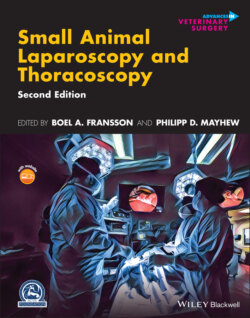Читать книгу Small Animal Laparoscopy and Thoracoscopy - Группа авторов - Страница 104
Obturator
ОглавлениеAn obturator is the tool (either sharp or blunt) that allows the cannula to penetrate the abdomen for initial placement. Although it once was used to refer solely to the piercing tool (obturator), as mentioned earlier, the term trocar is now often used to refer to the whole assembly. The pointed pyramidal tip from which the trocar gained its name is now one of several different types available, with outer diameters ranging from around 2–15 mm [3]. Other designs include flat double‐edged blades and pointed conical tips. Bladed trocars reduce the amount of force needed for the instrument to pass through the abdominal wall. For increased safety, some designs now include a spring‐loaded plastic shield that automatically covers the blade as it enters the abdominal cavity. Conical tips can be either metal or plastic and require a small initial incision to be made using a scalpel. They pass through the tissues of the abdominal wall by stretching rather than cutting them. This leads to improved sleeve retention because it is surrounded by intact tissue layers that help hold it in place [3].
Today, a very wide range of precision‐engineered laparoscopic trocars exist, which has revolutionized patient care as we know it. Surgical trocars in human medicine are most commonly a single‐patient use instrument and have graduated from the “three‐point” design that gave them their name to either a flat bladed “dilating tip” product or something that is entirely blade free. In veterinary medicine, the most commonly used trocar assemblies are reusable, reautoclavable configurations made of stainless steel or plastic or silicone materials.
